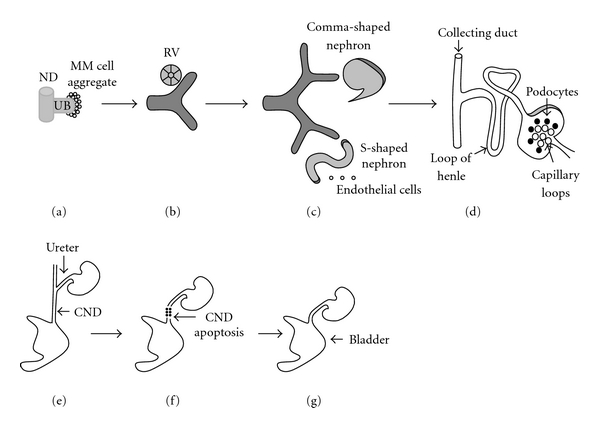Figure 1.

Schematic representation of normal development of the kidney and urinary tract. (a): Invasion of the metanephric mesenchyme (MM) by the ureteric bud (UB) on weeks 5-6 of gestation induces MM cells to aggregate around the UB tip. (a)–(c): UB outgrowth from the nephric duct (ND), its subsequent iterative branching (branching morphogenesis), and continuous condensation of the MM cells around emerging UB tips are induced primarily by reciprocal interactions among glial-derived neurotrophic factor (GDNF), its receptor c-Ret, and coreceptor GFRα1. (b): MM cell aggregates undergo mesenchymal-to-epithelial transformation (MET) to form the renal vesicle (RV) on weeks 6–36 of gestation. (c): RV elongates along the proximal-distal axis to form comma-shaped and then S-shaped nephron. Distal ends of S-shaped nephrons fuse with UB-derived collecting ducts, whereas proximal clefts form glomeruli. Endothelial cells migrate into the proximal cleft. UB branching occurs on weeks 6–22 of gestation. Formation of nascent nephrons and their patterning occur on weeks 6–36 of gestation. (d): Patterning of the S-shaped nephron and UB result in formation of mature nephron which contains glomerulat capillary tuft, podocytes, proximal tubule, loop of Henle, distal tubule, and collecting duct. (e). Ureter becomes patent and common ND (CND) fuses with cloaca on weeks 4-5 of gestation. (f): Apoptosis of the CND accounts for the positioning of the ureter (derived from proximal UB) in proximity of the urogenital sinus on weeks 5-6 of gestation. (g): Ureter fuses with the bladder by 6 weeks of gestation (with kind permission from Springer Science + Business Media: [82]). Please see text for details.
